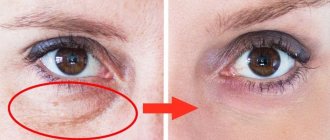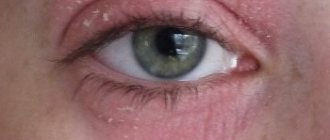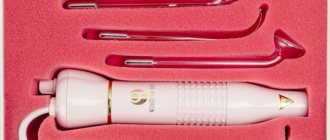Cosmetic eyelid surgery, or blepharoplasty, is an operation aimed at eliminating fat along with excess skin or muscle on the upper and lower eyelids. With the help of blepharoplasty, you can correct age-related drooping of the tissues of the upper eyelids (“heavy eyelids”) and “bags” under the eyes, which make you look older and look tired. However, this operation will not be able to eliminate facial wrinkles in the outer corners of the eyes (the so-called “crow’s feet”), dark circles under the eyes, or drooping eyebrows.
Of course, blepharoplasty will improve your appearance and boost your confidence, but the results may not match your ideals, so carefully consider your expectations and discuss all these issues with your surgeon.
The most common candidates for surgery are women and men aged 35-60 years, but treatment can be effective both in younger (in the case of a hereditary (family) factor of “bags” under the eyes and “heavy” eyelids) and in older in old age (70 and even 80 years old).
Blepharoplasty can be performed in isolation or simultaneously with other plastic surgeries such as a circular facelift or correction of drooping eyebrows. If the operation is performed by a qualified plastic surgeon, then complications are quite rare and minimal.
Possible complications:
- An allergic reaction to the anesthetic may occur.
- Infection.
Minor consequences include:
- temporary swelling in the corners of the eyes;
- slight asymmetry in scars;
- temporary difficulty closing the eyes;
- temporary inversion of the eyelid.
Reasons and indications
Eyelid surgery is performed if the fairer sex has:
- age-related changes that must be corrected. Usually, with age, a woman’s facial muscles weaken, the skin around the eyes begins to fade very quickly;
- congenital features in the structure of the face;
- consequences of life events that contribute to the appearance of defects in appearance. For example, a lady could get into a car accident and get severely burned;
- severe swelling, “bags” localized under the eyes. Such bags add brightness to bruises localized in this area, and also add age to the lady;
- personal desire to adjust your appearance, because... the fairer sex believes that this makes her more beautiful. Usually, with the help of laser blepharoplasty, a woman seeks to change the size of her eyes;
- asymmetrically located eyeballs;
- severely drooping corners of the eyes.
Laser blepharoplasty is a fairly popular procedure that is performed on patients aged 35 to 40 years. It is at this time that the skin of the fairer sex begins to quickly fade, the facial muscles weaken, and age-related changes immediately become noticeable on the lady’s face.
Types, methods and principles of eyelid surgery
Drooping eyelid skin is removed in two ways:
- routine surgical operations;
- laser exposure.
Most often, representatives of the fairer sex undergo laser correction.
Why is she in such demand?
It's simple.
During this procedure:
- a woman can recover very quickly. Usually damaged skin is completely restored after 3-4 weeks. And during a conventional surgical operation, the patient needs 2-3 months to recover;
- and after it the patient does not develop hematomas. During the procedure, the laser beam cauterizes small vessels, so the fairer sex does not develop blood;
- and after it, the fairer sex will never develop scars;
- infection does not penetrate into the site of exposure. The laser beam cauterizes all vessels and disinfects the site of exposure;
- and after it, a woman can quickly notice the effect. Moreover, this effect is long lasting and lasts from 5 to 11 years;
- and before her, a woman must familiarize herself with the list of contraindications. Moreover, it differs significantly from traditional surgical intervention, because it is somewhat smaller.
In addition, the doctor:
- During the procedure, he controls all his actions through a computer monitor. So he can determine the depth and length of the cut, the intensity of the laser beam;
- has a very quick effect on the problem area. The operation itself does not last long;
- during surgery it never comes into contact with the patient’s blood;
- Before the procedure, he can choose what kind of influence he will carry out. Using a laser beam, it can affect fat or muscle tissue;
- does not injure neighboring tissues, never encounters a negative reaction of the body to the impact;
- should warn the patient that in the first days after surgery she will have swelling on her face. It occurs due to a slowdown in the process of lymph outflow from the body. The swelling goes away on its own. There is no need to treat them;
- may allow the patient to go home a few hours after exposure.
Of course, laser blepharoplasty has many advantages, but before going for it, it would be a good idea for the patient to get acquainted with the list of contraindications. And if a representative of the fairer sex has chronic diseases or allergies, then the doctor should be informed about it. Otherwise, there will be no positive effect from such influence. This can also lead to dangerous complications.
Conventionally, doctors divide all laser blepharoplasty into several main types.
It is divided into:
- Laser blepharoplasty of the upper eyelids. During the procedure, the doctor cuts the skin and removes excess fatty tissue and skin. This operation relieves heavy and drooping upper eyelids. Moreover, all cuts are made with a laser beam. It is through them that the doctor has access to the place where he needs to remove fatty tissue, excess skin, and tighten the muscles under the eyes.
- Laser blepharoplasty of the lower eyelids. This operation eliminates bags, hernias under the eyes, and swelling, which together significantly add age to the fairer sex.
Moreover, the procedure is carried out in two different ways:
- percutaneous subciliary method. During it, the tissue is cut along the ciliary edge;
- transconjunctival way. With this effect, the physician makes an incision in the skin on the inner surface of the eyelid. During the procedure, the doctor removes fat deposits, excess skin, and helps tighten the eye muscles.
- Circular facelift. During this operation, the doctor changes the shape of the lower and upper eyelids at the same time. This effect is considered one of the most difficult in cosmetology.
- Correction of eye shape. This operation is especially popular among women with Asian appearance. In this case, the doctor removes the “Mongolian fold” and makes a European fold from it.
- Canthopexy. This operation is performed on patients with damaged ligaments in the eyelid area. During the procedure, the doctor not only corrects the shape of the eyes, but also the patient’s gaze.
After laser blepharoplasty, the patient receives a more lasting and visible effect. But if a representative of the fairer sex wants to remove age-related changes localized near the eyes, then she should not immediately go under a knife or a laser beam.
You can get rid of all problems in a conservative way.
For example, a lady can do fractional thermolysis.
During this procedure, the doctor applies high temperatures to the surface of the skin, and thus relieves the patient of many problems. In terms of technique, photothermolysis is no different from fractional thermolysis, but the procedure is carried out with a laser beam.
Fractional thermolysis relieves the fairer sex from many problems.
He:
- rejuvenates the face and body;
- helps get rid of wrinkles, the effects of acne, scars.
The uniqueness of this procedure is that during it the doctor does not make any incisions to the patient. Only an erbium laser is used, which has a targeted effect on problem areas of the skin. During such an effect, the doctor removes the top layer of skin, dead skin areas, and accelerates the process of renewal of dermal cells.
Why is this particular procedure done?
It's simple. She has many positive qualities.
For example, this procedure:
- safe. Moreover, this is the safest laser correction method of all available. During this procedure, the specialist applies a laser to the problem area and does not touch adjacent tissues;
- considered very delicate. Fractional thermolysis has a gentle effect on the surface of the face;
- very physiological. During such exposure, the doctor damages the upper cells of the skin of the dermis. Due to this, the skin recovers faster and rejuvenates;
- has a very lasting effect. After fractional thermolysis, a representative of the fairer sex can enjoy her new face for another 2 years, and even after such an effect she recovers incredibly quickly;
- absolutely painless. During it, the physician applies anesthetic medicinal compounds to the patient’s skin. Due to this, the risk of pain in the woman is minimal.
In general, the fractional thermolysis procedure lasts 20-45 minutes. And they do it using the Fraxel laser.
If a representative of the fairer sex strictly follows all the doctor’s recommendations, the doctor has taken into account the entire list of contraindications that the woman has, then even after non-surgical treatment she will not have complications. Redness and flaking of the skin after the procedure is considered normal.
Additionally, female representatives can undergo laser facial resurfacing. During this procedure, the doctor also does not cut the patient’s skin. The impact is carried out with a carbon dioxide laser. It is he who evaporates the upper layer of the dermis. Moreover, the patient’s skin is not injured.
The duration of the procedure varies from 30 minutes to 1 hour. Doctors recommend that a woman undergo at least 5 procedures. The effect of this procedure lasts for a very long time.
Decide to proceed with surgery
Whether your surgery is desired for functional or cosmetic reasons, choosing a qualified facial plastic surgeon is of utmost importance. Our facial plastic and cosmetic plastic surgeons are trained in both head and neck surgery, otolaryngology, and facial plastic and cosmetic surgery, providing you, the patient, with the highest level of training and experience. You should be informed to the greatest extent possible before deciding to have cosmetic surgery. Cosmetic surgery is an elective procedure, meaning that it is a personal choice and is not necessary to maintain good health.
You can expect a detailed explanation from the doctor regarding the different types of surgical and non-surgical procedures. Your doctor will tell you about the best anesthesia techniques, the surgical facility where your procedure will take place, and the benefits and risks associated with the surgery. Once you and your surgeon have made a joint decision to proceed with the procedure, photographs of you will be taken and your options will be further discussed.
Good communication between you and the doctor and realistic expectations are prerequisites for a successful outcome. You're more likely to be happy with the results if you have a realistic idea of what the surgery can and can't do. Please do not hesitate to seek the opinion of another physician if you are unsure of the surgeon's advice. You are the most qualified person to choose the surgeon that is right for you. The goal is to create a natural, aesthetic and balanced look.
Preparing for surgery
For the operation to be successful, the patient needs to follow these simple rules.
She needs:
- Stop drinking alcoholic beverages and smoking tobacco. It is necessary to refuse them 5-7 days before the exposure.
- Avoid physical and emotional stress.
- Stop taking medications that contain aspirin, analgin, and hormonal substances.
- Donate blood and urine for analysis.
- Go to an appointment with a cardiologist. He needs to get the result of the examination. Only examination tests performed 1 month before the date of surgery are accepted.
- Get an opinion from a dermatologist, neurologist, surgeon, therapist.
Remember: 5-6 hours before the operation, the fairer sex will have to refuse to eat.
The day before the operation, the fairer sex needs to get enough sleep and exclude from her food foods high in allergenic substances, dyes, and preservatives.
Remember: laser blepharoplasty is performed under local anesthesia. With this degree of exposure, the nerve cells are “frozen,” and the patient’s sensitivity is somewhat reduced.
Do not forget that during the operation the female representative will feel everything, but she will not experience pain.
Moreover, especially severe pain appears at the time of anesthesia.
After the procedure, the patient is given another anesthetic injection. He will help her get rid of the pain that she may experience when recovering from anesthesia.
Sometimes doctors put the patient under general anesthesia. It is used if she is undergoing simultaneous surgery on the upper and lower eyelids. This operation takes a very long time, but the fairer sex does not experience any pain.
If a representative of the fairer sex experiences severe pain after surgery, she should immediately report it to her doctor. Ignoring these symptoms can lead to a lack of effect and a deterioration in the patient’s health.
Stages of eyelid surgery
Laser blepharoplasty is performed in a hospital. The uniqueness of this procedure is that the doctor applies a short-term laser beam to the skin, but it does not violate the integrity of nearby tissues. Moreover, laser blepharoplasty includes several multifunctional complexes that reproduce erbium light waves with a size of 2940 HM. The beam penetrates 1 micron under the skin. This is why the skin recovers very quickly after surgery, and the risk of scarring is reduced.
The procedure consists of several stages.
Doctor:
- Lines the eyelids with a special hypoallergenic marker.
- A special lens is placed on the pupil, which protects the eyeball from the negative effects of laser beams.
- Applies an anesthetic cream to the treated area or gives the patient an injection with an anesthetic substance.
- After 20-30 minutes, the tissue is corrected with a special laser beam.
- Glues the edges of the wound.
- Lubricates the treated area with anesthetic gel. It reduces the risk of edema in the patient and relieves her of pain.
The operation itself lasts from 25 minutes to 1 hour. And another 20-30 minutes are required to activate the anesthesia. This also includes the rehabilitation period. This is 1-2 hours. It is at this time that the patient will have to stay in the hospital. In general, everything takes 4 hours.
The operation may take up to 1 day. This happens in emergency cases. The surgeon needs to make an emergency decision, which depends on the circumstances that have arisen, the patient’s recovery period, and her state of health.
After the operation, the doctor gives the patient recommendations and sends him home.
Laser blepharoplasty cannot be called a completely safe procedure. It cannot be performed on all patients.
For example, it is prohibited if a lady has:
- constant feeling of dryness in the eye;
- relapses of somatic diseases;
- elevated blood sugar levels;
- pathologies localized in the endocrine system;
- disturbances in the functioning of the cardiovascular system;
- malignant and benign neoplasms. Moreover, their location does not play a special role;
- progressive infectious diseases;
- fever;
- unstable mental state;
- epileptic seizures;
- paranoid desire to change one's appearance with the help of a plastic surgeon.
The procedure is also prohibited for women who are pregnant or breastfeeding.
Remember: the doctor may temporarily refuse to perform surgery on the patient. Some contraindications can be removed with medications. And some contraindications are eliminated on their own.
Initial consultation
Friends, family or colleagues who have undergone facial and cosmetic plastic surgery are often willing to share their experiences. It is often helpful to talk to these people before considering surgery.
The initial consultation gives you and your doctor the opportunity to fully discuss your intended procedures.
Here are some of the questions you can ask:
- Am I a good candidate for this procedure?
- What is the real result for me after surgery?
- How long will the operation take?
- What is the recovery time?
- What are the risks?
- Is postoperative treatment necessary?
- How much does the procedure cost?
It is recommended that you write down the answers your doctor gives you so that you can review them carefully later. The consultation also gives you the opportunity to meet with the surgeon to determine whether you are comfortable with him or her.
Cosmetic surgery is not a guarantee of happiness, success in life or relationships, and you need a realistic expectation before undergoing surgery. Please think carefully about the reason you are considering surgery and why at this stage of your life. Suitable cosmetic surgery patients are currently happy in their lives and are not obsessed with their appearance. These patients seek to improve their appearance with small changes and understand that the end result will not be perfect.
If you constantly think about your appearance, experience life problems and other stressors, you may need psychological help rather than cosmetic surgery.
Rehabilitation after surgery
The fairer sex recovers very quickly after such exposure. But it is important that she follows all the doctor’s recommendations.
He needs:
- In the first 1-2 days, apply cooling compresses to the treated area. They are applied 2-3 times a day.
- At night, take a position and be 45 degrees above the floor level. You cannot lie on your side or stomach, i.e. The face should not touch the pillow.
- Do not use decorative cosmetics and cosmetics containing fragrances, dyes, and flavors. They should not be used until the face has completely healed.
- Do not use medications that contain aspirin or analgin.
- Do not overheat the skin and do not create a “greenhouse effect” for the body. Baths, saunas, beaches and solariums are strictly prohibited. You can visit them only after complete restoration of the skin.
- Avoid physical and emotional stress.
- Before going outside, use protective equipment with different protection factors. Moreover, they are used at any time of the year, in any weather.
- Do not touch formed scars. They should go away on their own in 2-3 weeks.
- Use cosmetics only 10 days after exposure. Moreover, you should start only with decorative hypoallergenic cosmetics. Otherwise, the fairer sex will develop severe allergies on her face.
If the patient strictly follows all the doctor’s recommendations, then her rehabilitation will go very quickly. Typically rehabilitation lasts 1 month.
But if she does not follow the recommendations, she will have dangerous complications.
For example, she may have:
- excessive dryness in the eyes, feeling of sand in them;
- excessive tearing. This occurs due to disruption of the sebaceous glands. Their work is restored 2 weeks after exposure, but the patient will have to take eye drops recommended by the doctor;
- severe pain. To get rid of them, the fairer sex is prescribed painkillers. But you can take them only after consulting your doctor.
She may also have:
- bruises, hematomas, swelling in the treated area. This occurs due to the close location of the vessels to the surface of the skin in the area of exposure, damage to their integrity during exposure;
- asymmetrical arrangement of the eyeballs. This is caused by the unskilled work of a specialist or the characteristics of the patient’s body;
- postoperative burn. The use of a carbon dioxide laser by a specialist results in the formation of burns.
Remember: complications in the fairer sex are extremely rare. But if they appear, then she should immediately consult a specialist.
Eyelid correction is becoming an increasingly popular procedure every year. The trend is quite understandable, because the beauty and youth of the face depends on the appearance of the eyes. Eyelid surgery helps eliminate problems such as wrinkles, fatty hernias, dark circles and bags under the eyes. At the same time, we should not forget that any surgical intervention in this area is a serious procedure, so you should take a very responsible approach to choosing a clinic and an operating doctor.
Eyelid lift – correction of age-related changes
An eyelid lift is a surgical procedure that tightens the skin on the eyelids and corrects their shape. Its essence lies in the excision of excess skin and fatty formations in order to correct age-related changes.
A facelift is a unique operation, thanks to which doctors achieve highly aesthetic results without scars or scars. The effectiveness associated with low trauma puts eyelid surgery among the best methods of plastic surgery.
Eyelid surgery – before and after photos clearly demonstrate the result:
Side effects
When you see a plastic surgeon, you will definitely learn about a number of side effects. Some go away within a week, while other complications are the consequences of non-compliance with the doctor’s instructions or his poor quality of work.
There are also cases of individual intolerance to drugs used during surgery or in the postoperative period.
Possible complications:
- bleeding or accumulation of blood behind the eyeball associated with vascular damage;
- inability to close the eyes due to severe swelling;
- constant burning in the eyes and peeling of the skin;
- inflammatory process due to the ingress of viruses and bacteria;
- secretion of tears;
- reaction to bright light;
- hematomas;
- eye asymmetry;
- vision problems;
- tissue scarring or suture dehiscence;
- incomplete closure of the eyelids or “winding of the eyes”;
- cysts that appear on suture lines;
- the presence of wounds formed due to improper antibacterial treatment of sutures.
Only some of the complications after blepharoplasty are considered to be mistakes of surgeons, namely: violation of symmetry, blurred vision and drooping eyelid. Therefore, we strongly recommend choosing your plastic surgery clinic carefully. At your appointment with the surgeon, do not hesitate to ask for permission to provide such services.
Indications for eyelid correction
Eyelid correction is not always “age-related correction”. Very often, patients aged 25-30 years resort to the procedure.
The main indications are as follows:
- ptosis – drooping eyelids;
- mimic and deep wrinkles;
- bags under the eyes;
- fatty hernias;
- asymmetry in the shape of the eyes or the shape of the eyelids;
- presence of depressions;
- narrowing of the field of vision due to anatomically irregular shape of the eyelids;
- “Asian eyelid” with overhanging tissue.
Preparing for surgery
Before eyelid surgery, the patient must undergo diagnostics, including the following studies:
- blood tests - general, clinical, assessment of coagulation and HIV status, determination of glucose levels, group and Rh factor;
- general urine analysis;
- electrocardiography of the heart;
- X-ray of the lungs.
In addition, consultation with a therapist is indicated. The medical examination is aimed at assessing the patient’s current health status, identifying contraindications to eyelid lift surgery and studying the physiological characteristics of the body, which will help avoid the development of complications in the future.
Based on the results of the examinations completed, the doctor determines the possibility of eyelid correction and the extent of surgical intervention.
Eyelid lift – surgery
The operation is performed under anesthesia. The anesthesiologist calculates the type of anesthesia and dosage of drugs individually. The intervention lasts from 30 minutes to 1.5 hours.
Taking into account the volume and goals pursued, there are three main options for a facelift:
- classical;
- transconjunctival;
- complex.
With the classic method of eyelid correction surgery, the surgeon removes excess tissue, carefully tightens the skin and applies sutures.
The transconjunctival method allows you to perform eyelid lift surgery without suturing. The doctor makes a small incision in the area of the lower fornix of the conjunctiva. Due to the fact that the conjunctival membrane is able to regenerate on its own, the wound heals on its own. However, this method will not be effective in advanced cases (for example, with severe ptosis); it is used only in the early stages.
Carrying out a complex operation will allow you to tighten the upper and lower eyelids at once. During surgery, additional manipulations can be used - face lifting, lipofilling and others.
Medical history
It is important that you are open with your doctor and his staff about your medical history so that he can plan the best treatment. This information is strictly confidential. Please inform him of any nuances:
- Previous facial and/or cosmetic surgeries (nose, eyelids, chest, etc.)
- Past or current medical conditions such as heart, lung, or kidney disease, prolonged bleeding or excessive bruising, blood clots in the legs or lungs, or stomach reflux.
- Modern medications, especially aspirin, Plavix, Iscover, anti-inflammatories, warfarin, blood thinners, insulin and oral contraceptives.
- Allergies or adverse reactions to antibiotics, anesthetics or other medications.
- Psychological and psychiatric diseases
- Keloid scarring or poor healing
- Connective tissue disorders such as rheumatoid arthritis, lupus erythematosus, scleroderma or similar
- Previous radiation therapy to the head, neck or breast area.
Your surgeon will then review your specific needs and, after discussing your options and specific risks and benefits, recommend the procedures that are most appropriate for you. We respect your privacy.
Rehabilitation period
If the eyelid lift was performed under local anesthesia, the patient may be discharged within a few hours. When using general anesthesia, it is recommended to stay in the hospital until the morning. The next doctor's visit will take place in 7 days. At the appointment, stitches are removed, if they were applied, and the result is assessed.
In the first week after surgery, unpleasant symptoms may appear: redness, swelling and soreness of the skin around the eyes. If the recovery period is positive, they disappear within a few days. 1-1.5 weeks after eyelid correction, pain subsides. After just a month and a half, the skin is completely restored: there are no traces of the intervention left on it.
Contraindications to blepharoplasty
Typical contraindications for eyelid surgery are the same as for other types of surgical treatment. Whether they are absolute or relative (i.e., surmountable or negligible) is determined during preoperative diagnosis. When making a decision, the ratio of possible risks and predicted benefits of the intervention is assessed mainly. Specific restrictions may be imposed, first of all, by diseases of the visual system (acute and chronic diseases of the conjunctiva, lacrimal glands and ducts, dry eye syndrome, blepharochalasis (excessive swelling around the eyes), blepharospasm, hyperthyroidism and a number of other ophthalmopathological conditions. In this case, advisory participation an ophthalmologist is strictly necessary.











